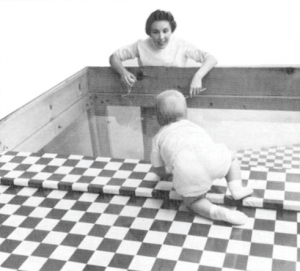Jumping spiders are known for their ability to leap and from one point to another, a mechanism that can assist in escape as well as predation, as jumping spiders pounce on their prey. As you might imagine, high velocity jumps require spiders to have excellent visual systems – systems that are particularly attuned to the perception of depth. There are many different visual systems in the animal kingdom. Jumping spiders, which have four pairs of eyes, have a system that allows them to perceive differences between objects that are 0.12 mm apart from 200 mm away. The front pair of eyes is forward facing and is responsible for the detection of color and for the high resolution with which images are perceived. This front pair is also theoretically able to perceive depth with only one eye functioning. Meanwhile, the other three pairs of eyes are responsible for giving the spiders almost 360o visual fields. One of these three pairs is speculated to give spiders the ability to perceive depth by using both eyes. However, the perception and limitations of jumping spider depth perception has been largely neglected in studies up to this point, as most studies have focused on the physiology behind spider vision. In their study on the ability of jumping spiders, Samuel Aguilar-Arguello et al. investigated the ability of jumping spiders to perceive depth using information from textural cues and whether their processing of textural information is similar to human processing. They predicted that processing would be similar to human and cephalopod perception because of prior, related studies done on cephalopods which have the same individual eye structures as jumping spiders.

Eyes of the Jumping Spider. Wiki Commons.
Aguilar-Arguello et al. conducted numerous trials, each for different purposes. The first one was intended to evaluate a spider’s preference for a high or low drops. This was done by using optical illusions in a ‘visual cliff experiment’. This method is commonly used by scientists studying how animals perceive depth. In this experiment jumping spiders were set on a platform with the option of proceeding forward by walking over a 40 mm drop, or a high drop of 440 mm. Spider preference for the low drop was demonstrated in the results of this experiment, showing that they do prefer lower drops opposed to higher ones. However, the experiment did not prove anything about their perceptual relationship with texture because the drops were real, not optical illusions on a flat surface.

Visual cliff experiment on a human baby. Wiki Commons.
The second experiment placed two different patterns under a tank of water. Both patterns were at the same depth, but one pattern used distortion of the checkerboard to create the illusion of a trench. The other pattern was consistent, normal checkerboard pattern. Spiders did not show a preference for the trench pattern or the normal pattern, indicating that texture did not affect their perception of depth in this experiment.
The third experiment tested the ability of jumping spiders to perceive depth from illusory information only, meaning that there were no real drops in this experiment. This experiment placed patterns at the same height under a glass platform, but changed the sizes of the checkerboard in two sections. One had smaller checkers to indicate a greater depth and the other had larger checkers to indicate a shallow drop. Like the second experiment, spiders showed no preference for illusions depicting flatness or drops.
In the fourth and final experiment various eyes were blocked in the spiders to determine if blocking one of the forward facing eyes, the pair of side-facing eyes that have the ability to perceive depth, or a combination of the two had any effect on spider behavior, depth perception. They concluded, after an experiment that involved altering heights of drops while covering different combinations of eyes, that spiders showed no statistically significant preference for high or low drops caused by the blocking of different types of eyes.

Another beautiful jumping spider. Wiki Commons.
To reiterate, this work demonstrated that spiders do not rely on texture as a cue of depth, though they can perceive depth and have preferences for jumping over lower gaps. This indicates that perception of depth in jumping spiders is different from that of human beings and cephalopods. Further studies are needed to determine whether the type of light used in these experiments would have an impact on perception of texture – perhaps light with a different wavelength might change results. These results are significant because they demonstrate that visual systems do not always work in the same way as our own and invite further scientific investigation of the physiology and perception of both humans and jumping spiders. Optical illusions are demonstrations of fallacies in our own visual systems. This experiment shows that jumping spiders may not have the same needs or faults in their own visual systems, a concept that invites readers of the study to contemplate an entirely different way of perceiving the world.
Reference: Aguilar-Arguello, S., Taylor, A.H., & Nelson, X.J. (2022). Jumping spiders do not seem fooled by texture gradient illusions. Behavioural Processes, 196, 104603. doi: 10.1016/j.beproc.2022.104603.
